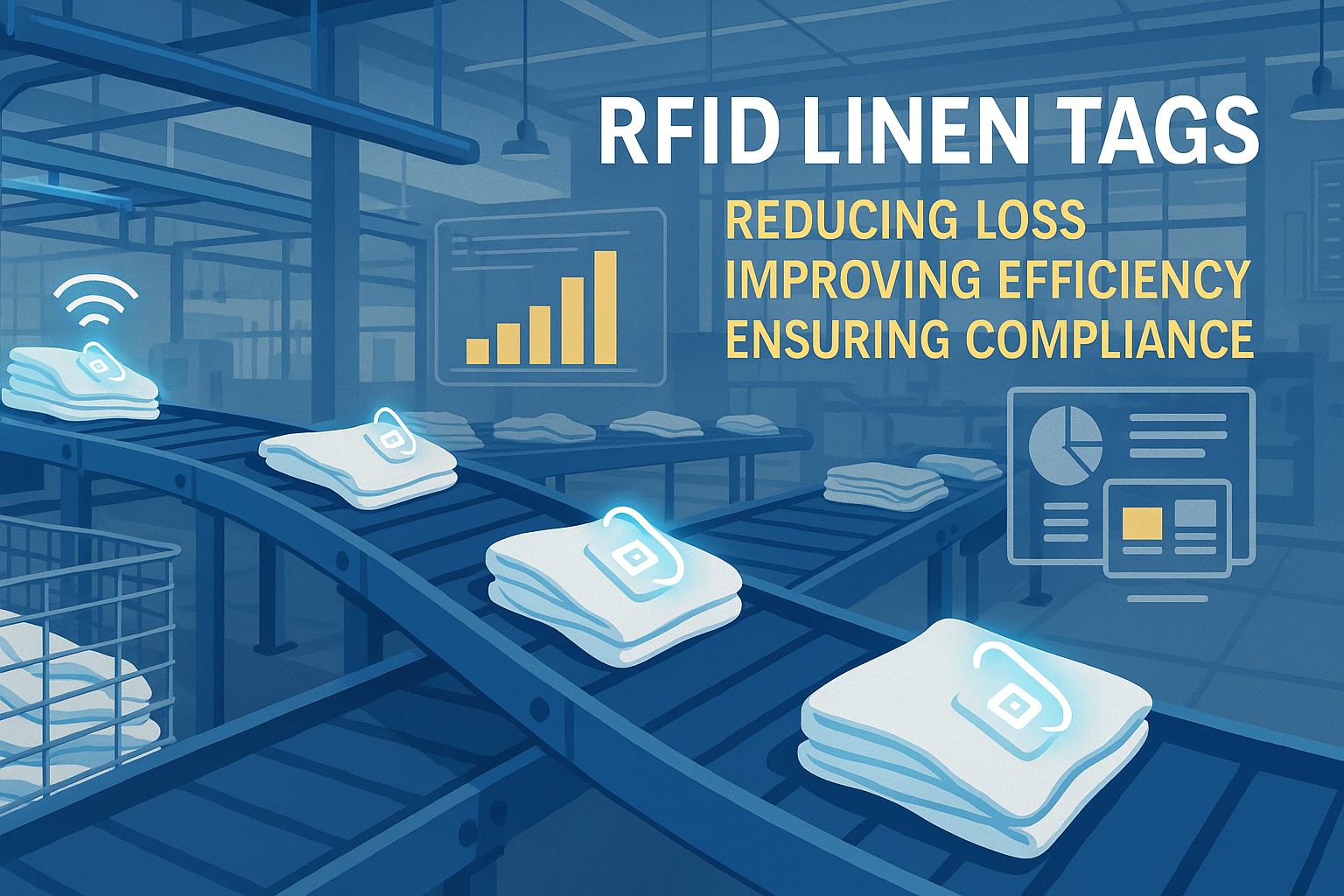
RF タグと RFID タグの違いは何ですか?
目次
RFタグとRFIDタグの違い:定義、技術、倉庫管理における応用
しかし、これらの用語はしばしば混同されて使用されるため、その真の意味や違いについて混乱が生じます。RFとRFIDの違いを理解することは、企業が業務を最適化し、効率を向上させ、より賢明な技術投資を行う上で役立ちます。.
このガイドでは、RF技術と RFIDタグ RFID技術とは何か、その仕組み、違い、そして現代のサプライチェーンを変革している理由について解説します。.

RF技術とは何か、そしてどのように機能するのか?
RF(無線周波数)とは、電磁波である電波を用いてデータを無線で伝送する技術を指す。RFID技術、Wi-Fi、Bluetoothなど、複数の無線通信システムの基盤となっている。.
RF技術の主要構成要素:
- 送信機と受信機:無線信号を生成し、捕捉する。.
- 周波数範囲:用途に応じて、数キロヘルツ(kHz)からギガヘルツ(GHz)まで動作します。.
- 用途:通信システム、ガレージドアリモコン、ワイヤレスマイク、セキュリティシステムなどで広く使用されています。.
要するに、RF技術は識別、通信、データ交換を可能にする無線基盤を提供し、RFID技術はその中でも最も専門的な応用例の一つである。.
RFID とは何ですか? どのように機能しますか?
RFID(無線周波数識別)は、RF技術に基づいて構築され、タグ付けされた対象物の無線による識別と追跡を可能にします。.
RFIDシステムは以下で構成される:
- RFIDタグ
- RFIDリーダー
- アンテナおよびソフトウェアシステム
RFID技術の仕組み:
- 読者活性化: RFIDリーダー アンテナを介して無線信号を送信する。.
- タグ応答:RFIDタグはその信号からエネルギーを捕捉し、保存されたデータを送信する。.
- データ収集:リーダーはタグの応答を受信し、データを中央データベースまたは倉庫管理システム(WMS)に転送する。.
バーコードとは異なり、RFIDタグは視線スキャンを必要としないため、複数のタグを同時に読み取ることが可能であり、混雑した環境での効率性を向上させます。.
RFとRFIDの違い
RFは無線通信の広範なカテゴリーを表す一方、RFIDは物品識別とデータ追跡を目的として設計されたRF技術の具体的な実装形態である。.
| 特徴 | 無線周波数 | RFID |
|---|---|---|
| 意味 | 無線通信における電波の一般的な利用 | RFを用いた物体識別および追跡への応用 |
| 主要コンポーネント | 送信機と受信機 | タグ、リーダー、アンテナ、および管理ソフトウェア |
| 通信タイプ | 基本的な信号伝送 | 双方向識別とデータ交換 |
| アプリケーション | ラジオ、リモコン、Wi-Fi、セキュリティシステム | 倉庫管理、物流、小売、アクセス制御 |
| データ機能性 | 生信号データを転送する | 物理資産に関連付けられたデジタル情報を転送する |
RFIDタグの仕組み
RFIDタグは、データを保存しRFIDリーダーに送信する小型デバイスです。各タグには以下が含まれます:
- マイクロチップ(IC):固有の識別データを保存します。.
- アンテナ:エネルギーを受信し、信号を送信する。.
- 基板/インレイ:内部部品を保護します。.
RFIDタグがリーダーの検知範囲に入ると、固有IDや製品コードなどのデータを送信します。これにより、倉庫やサプライチェーン全体の業務をリアルタイムで可視化することが可能になります。.
RFIDタグの種類
1. パッシブ型RFIDタグ
- 電源:内蔵バッテリーなし。リーダーの信号で駆動。.
- 範囲:数センチメートルから数メートル。.
- 用途:小売、在庫管理、および商品単位のタグ付け。.
2. アクティブ型RFIDタグ
- 電源:連続信号伝送用の内蔵バッテリー。.
- 範囲:最大100メートル以上。.
- 用途:車両追跡、フリート管理、大型資産監視。.
能動型RFIDタグと受動型RFIDタグの選択は、通信距離の要件、タグの寿命、および予算によって決まります。.
倉庫管理におけるRFID技術の応用
RFID技術は、自動化、正確性、透明性を提供することで、倉庫およびサプライチェーン業務を変革している。.
主要な倉庫アプリケーション:
- 在庫管理:在庫レベルと品目の所在をリアルタイムで可視化。.
- ドック管理:施設への入出庫時に貨物の移動を追跡します。.
- 資産追跡:高価値物品の責任追及可能性と追跡可能性を確保します。.
- 業務効率:手動スキャンによる誤りを減らし、人件費を削減します。.
“RFIDタグを採用した倉庫では、バーコードシステムと比較して最大20倍の在庫移動を処理できます。”
RFIDとNFC:関連性はあるが異なる
両方 NFC(近距離無線通信) RFIDはRF技術を使用するが、通信距離、目的、通信能力において異なる。.
| 特徴 | RFID | 非対称 |
|---|---|---|
| 範囲 | 長距離(最大100メートル) | 短距離(最大10cm) |
| 電源 | 能動態または受動態 | パッシブのみ |
| データ交換 | 一方通行 | 双方向(ピアツーピア) |
| アプリケーション | 倉庫管理、物流、資産追跡 | モバイル決済、本人確認、スマートアクセス |
NFCはRFID技術の特殊なサブセットと見なすことができ、安全な短距離データ交換に最適である一方、RFIDタグは産業用追跡や物流分野で主流となっている。.
セキュリティシステムにおけるRFの役割(EAS統合)
電子商品監視(EAS)システムは、小売店や倉庫環境での盗難防止にRFタグを一般的に使用します。.
RFタグセキュリティの仕組み:
- タグの配置:RFタグは商品に貼付されます。.
- 検知:セキュリティゲートは出口でアクティブタグをスキャンします。.
- 警告:アクティブなタグが通過した場合、システムが警報を発します。.
RFID技術を統合することで、EASシステムはレジ精算時や出荷時の検知精度と自動化が向上する。.

よくある質問
RFとRFIDの主な違いは何ですか?
RFとは電波を用いた一般的な無線通信を指します。RFIDは、RFIDタグとリーダーを用いた追跡・識別のために使用される特定のRF技術です。.
RFIDは倉庫管理においてバーコードに取って代わることができるか?
はい。RFIDタグは視認性を必要とせず、従来のバーコードよりも高速なデータ取得が可能で、耐久性に優れています。.
RFタグとRFIDタグは互換性がありますか?
いいえ。RFタグはより単純で、主に盗難防止システムに使用されます。RFIDタグはより高度で、追跡やデータ交換に使用されます。.
RFIDタグはどのように機能するのですか?
RFIDリーダーが信号を送信すると、タグが保存データを返答し、システムが自動的に記録する——リアルタイム在庫管理に最適です。.
結論
RF技術は現代通信の無線基盤であり、RFID技術はその上に構築され、スマートで自動化された識別システムを実現する。.
- 倉庫管理と物流において、リアルタイム追跡、自動化、正確性を実現するためにRFIDタグを活用する。.
- 汎用通信およびセンシング用途にRFシステムを使用する。.
RFとRFIDの違いを理解することで、企業は効率性を高め、コストを削減し、将来を見据えた業務運営を実現するための適切なツールを選択できます。.

レイ・ジョウ
この記事は、RFID技術の専門家であり、10年以上の業界経験を持つRay Zhouが執筆した。
コメント
人気商品

RFID廃棄物管理とは何か
想像してみてください。街中のゴミ箱がすべて「話す」街を――文字通りではなく――小さなチップを通じて、満杯になった時、空になった時、そしてどこへ運ばれたかをシステムに伝えるのです。それが今日のRFID廃棄物管理の仕組みです。.

ボルトシールとその用途とは?| 完全ガイド
世界的な貿易と物流において、ボルトシールは貨物のセキュリティとコンプライアンスを確保する上で重要な役割を果たしています。これらの小型で強力なデバイスは、タンパーエビデント機構で輸送コンテナ、トレーラー、貨物ドアをロックするように設計されています。

RFIDカードプロテクターとは?メリット、使用例、購入ガイド
RFID(Radio Frequency Identification)テクノロジーは、クレジットカード、IDバッジ、定期券、ホテルのルームキーなど、あらゆるところに浸透している。RFIDはスピードと利便性を提供する一方で、「スキミング」と呼ばれる新たなデジタル窃盗への扉も開いている。そこでRFIDカードプロテクターの出番です。

イベント用RFIDリストバンド:主催者向け一括購入ガイド
イベント用RFIDリストバンドは、コンサート、フェスティバル、スポーツ会場などで、迅速な入場、不正防止、キャッシュレス決済を必要とする主催者にとって、最適なソリューションになりつつあります。紙のチケットやQRコードとは異なり、これらのスマートリストバンドは埋め込みチップを使用し、アクセスを合理化し、取引を安全にし、ゲストの体験を向上させます。

フロントガラス上のRFIDタグが車両入退場管理と料金システムを改善する方法
ペースの速い今日の世界では、車両識別は迅速、安全、非接触である必要があります。フロントガラス上のRFIDタグは、まさにそれを提供します-車両を止めることなく、料金徴収、駐車、ゲートアクセスを管理する信頼性の高い方法です。

業務用ランドリーにおけるRFIDリネンタグの利点
病院やホテル、大規模なランドリーサービスでのランドリー管理は大仕事だ。毎日、何千枚ものシーツ、タオル、ユニフォームが洗濯され、仕分けされ、送り返されます。しかし、リネンの紛失、仕分けのミス、手作業による計数などの問題は、企業に多大な損失をもたらします。例えば、中規模のホテルでは、リネンの紛失によって毎年$200,000以上の損失が発生します。
そこでRFIDリネンタグの出番だ。
タグ
関連ブログ

RFID廃棄物管理とは何か
想像してみてください。街中のゴミ箱がすべて「話す」街を――文字通りではなく――小さなチップを通じて、満杯になった時、空になった時、そしてどこへ運ばれたかをシステムに伝えるのです。それが今日のRFID廃棄物管理の仕組みです。.

ボルトシールとその用途とは?| 完全ガイド
世界的な貿易と物流において、ボルトシールは貨物のセキュリティとコンプライアンスを確保する上で重要な役割を果たしています。これらの小型で強力なデバイスは、タンパーエビデント機構で輸送コンテナ、トレーラー、貨物ドアをロックするように設計されています。

RFIDカードプロテクターとは?メリット、使用例、購入ガイド
RFID(Radio Frequency Identification)テクノロジーは、クレジットカード、IDバッジ、定期券、ホテルのルームキーなど、あらゆるところに浸透している。RFIDはスピードと利便性を提供する一方で、「スキミング」と呼ばれる新たなデジタル窃盗への扉も開いている。そこでRFIDカードプロテクターの出番です。




